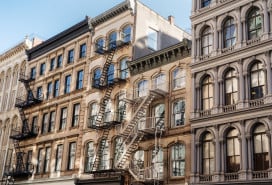How does the number of elevators in a building affect property values?

In a large high-rise, how does the number of elevators affect property values? And in buildings where you have to take an elevator to another set of stairs, is that considered a negative for buyers?
While it's important for a building to have a sufficient number of elevators to service the residents, say our experts, the number of elevators doesn't seem to have a clear impact on values one way or the other.
"It's too case-by-case to say," says Corcoran's Deanna Kory, "In most cases, buyers are unaware of the elevator situation and how it may impact them." Unless a buyer has previously run into problems with slow or insufficient elevator service, this issue may not be on their radar when evaluating a unit.
Generally speaking, says Kory, it's important that buildings beyond a certain height and number of residents have at least two elevators, so that residents won't be stranded if the building's lone lift is shut down for repairs. In buildings under 24 units and medium-sized mid-century construction, says Kory, it's fairly typical to have one elevator for residents, and one service elevator that often becomes a second residents' elevator in practice.
"If the building is rather tall and there are well over 100 or 150 units, some people do not like the fact that there are only two elevators in total," says Kory. "For those few who do know about it or bring it up, the lack of more elevators may prevent them from buying the unit at all! So the impact can be that it is a total turn-off, but that is not as common as one may think."
As far as situations where you'll be taking an elevator to further stairs, this is a rare setup, says Kory, and most often seen in penthouses, where other factors (such as significant outdoor space) offset the minor inconvenience. "Buyers for this type of apartment will sometimes climb the stairs, because they can get what they want as a result," she explains.
The only other time this tends to come up, she says, is if a building has been retrofitted from another use, or two buildings were combined and the floors don't match up. "In these cases, there is often no way to have an elevator going directly up to whatever apartment," says Kory. "For those apartments, the value would be affected in a negative way because most people don't want to climb stairs if they're buying in an elevator building."
You Might Also Like






















